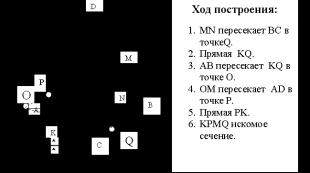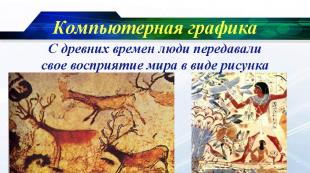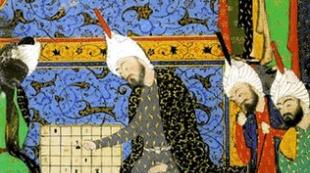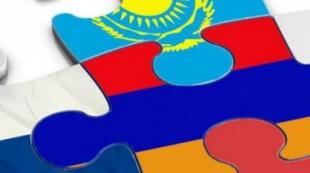From the history of chess. Origin of chess History of chess presentation
Slide 2
Slide 3
Origin of chess
An ancient Indian legend attributes the creation of chess to a certain Brahmin. For his invention, he asked the Raja for a minor reward: as many wheat grains as would be on the chessboard if one grain were placed on the first square, two grains on the second, four grains on the third, etc. It turned out that this amount of grain not on the entire planet. It’s hard to say whether it was true or not, but one way or another, India is the birthplace of chess.
Slide 4
The first game known to us, related to chess, chaturanga, appeared in India. There are two fundamental differences from modern chess: there were four players, not two (they played pairs against pairs), and moves were made in accordance with the results of throwing dice. Each player had four pieces (chariot (rook), knight, bishop, king) and four pawns. There was no queen at all. To win the game, it was necessary to destroy the entire enemy army.
Slide 5
The Arabs transformed chaturanga: there were two players, each received control of two sets of chaturanga pieces, one of the kings became a queen. They gave up the bones and began to walk one move at a time, strictly one at a time. Victory began to be recorded upon checkmate or stalemate, as well as upon completion of the game with a king and at least one piece against one king.
Slide 6
Around 820, chess appeared in Rus', coming either directly from Persia or from Central Asian peoples. The Russian name of the game is consonant with the Central Asian “chess”. Changes in the rules, later introduced by Europeans, penetrated into Rus', gradually turning old Russian chess into modern ones. It is believed that the European version of the chess game came to Russia in the 10th-11th centuries from Italy.
By the 15th century, chess acquired its modern appearance.
Slide 7
Ivan the Terrible played chess (according to legend, he died at the chessboard). Under Alexei Mikhailovich, chess was common among courtiers, and the ability to play it was common among diplomats. Documents from that time have been preserved in Europe, which say that Russian envoys were familiar with chess and played it very well. Princess Sophia was fond of chess. Under Peter I, assemblies could not be held without chess.
Slide 8
By the 15th-16th centuries, chess rules were basically established, and the development of systematic chess theory began. In 1561, Ruy Lopez published the first complete chess textbook, which covered the stages of the game - opening, middlegame and endgame. He was the first to describe a characteristic type of opening - a “gambit”, in which an advantage in development is achieved by sacrificing material.
Slide 9
History of chess
Philidor made a great contribution to the development of chess theory in the 18th century. He developed a positional style of play. He believed that a player should not rush into reckless attacks, but systematically build a strong, stable position, deliver precisely calculated attacks on the weaknesses of the enemy’s position, and, if necessary, resort to exchanges and simplifications if they lead to a profitable endgame. The correct position, according to Philidor, is, first of all, the correct placement of the pawns. According to Philidor, “Pawns are the soul of chess; Only they create attack and defense; victory or defeat entirely depends on their good or bad position.” Philidor's book "Analysis of the Game of Chess" has become a classic.
Slide 10
Since the 16th century, chess clubs began to appear, where amateurs and semi-professionals gathered, often playing for a monetary stake. Then national tournaments appeared in most European countries, and international matches (since 1821) and tournaments (since 1851) began to be held.
Slide 11
Adolf Andersen became the unofficial “chess king”; he was considered the strongest chess player in the world. This title was subsequently challenged by Paul Morphy (USA). Wilhelm Steinitz became the first world chess champion. The new world champion was the one who won the match against the previous one.
In 1924, the International Chess Federation (FIDE) was created, initially organizing the World Chess Olympiads.
Slide 12
The first official World Chess Championship was held in 1948, won by Soviet grandmaster Mikhail Botvinnik.
Now the computer can give hints to the chess player even at the highest level competitions. Therefore, tournaments began to use special measures to protect against computer hints.
The progress of computer chess has become one of the reasons for the growing popularity of non-classical chess variants.
Slide 16
The first “unified” world champion was Vladimir Kramnik (Russia).
The current world chess champion is Viswanathan Anand.
View all slides
Chess of the 2nd-3rd centuries. Eastern chess: India, Egypt, Iraq, Iran. The oldest form of chess. Chess in Europe X, XI century. The emergence of chess in Rus'.
Archaeological excavations indicate that games involving the movement of chips on a board were known back in the 3rd-4th centuries. BC e. The true age of the game known in the Western world as chess, shrouded in mystery.
Al-Biruni in the book “India” tells a legend that attributes the creation of chess to a certain Brahmin mathematician around 1000 BC. When the ruler asked how to reward him for this wonderful game, the mathematician replied: “Let's put one grain on the first square of the chessboard, two on the second, four on the third, and so on. So give me the amount of grain that will turn out.” if you fill all 64 cells." The ruler was delighted, believing that we were talking about 2-3 bags, but if you count 2 to the 64th power, it turns out that this number is greater than all the grain in the world.
According to another legend, chess was invented by one eastern sage, whose name was Shishah, and he lived in Babylon. Under him, the young king of Amolny sat on the throne, who greatly oppressed the lower strata of society, especially the peasants. In the greatest despair, the peasants turned to Shishakh, who was highly respected at the royal court, and asked him for help. Basically, they persuaded him to convince the king that the peasant was also a person who benefited the state. To convince the king of this, Shishakh invented chess and taught the king how to play chess. In this way he proved to him that the peasants, i.e. pawns on the board are still the best protection for the king. The king understood in this way the main idea of the chess game and stopped oppressing the peasants, and generously rewarded his adviser.

Based on another story, chess was invented by the wife of King Ravana of Ceylon. When everyone in his besieged capital had already lost heart and lost all courage to continue the fight, the desperate King Ravan decided to give the city to the enemy. But the king had a wife, Queen Ranalana, a heroic woman, and she invented the game of chess to prove to her husband that he should not surrender to the enemy until all means of defense were exhausted, until at least one pawn soldier remained on the board, until there is at least a faint hope of victory!
Scientific hypotheses push back the time of the creation of chess even further, to 2-3 millennia BC, based on archaeological discoveries in Egypt, Iraq, and India. However, since there is no mention in the literature of this game before 570 AD, many historians recognize this date as the birth of chess. The first mention of the game of chess was in a Persian poem from 600 CE, and in this poem the invention of chess is attributed to India.

Raja Krishna playing ancient chess chaturanga.
We offer interesting articles:
Performed by student of group AVT-18 Marina Zausaeva
Slide 2: What is chess?
Chess is a logic board game that combines elements of art, science and sports.
Slide 3: History of chess - who invented it and how chess arose
One of the most ancient and fascinating games is chess. It is known in every corner of the globe, so there are dozens of its variations in the world. This is not just a game, because chess has long been a sport and an art. Chess markings are used in almost all areas of life, and the game algorithm is used for scientific purposes. But where is its homeland and who invented it? There is still no clear and plausible opinion. Scientists argue, putting forward their versions.

Slide 4
Some publications confidently state that chess appeared in India sometime in the 6th century AD. e. You could read about this at the beginning of the 20th century in Harold Murray’s book “The History of Chess.” Yes, they invented the game there and at that time, but they invented it much earlier. Scientists have seriously taken up the study of this topic and have found many different versions, which are sometimes surprising with facts.

Slide 5
There is another option - a Korean legend. Once upon a time, 4500 years ago, the prototype of modern chess was the game that was invented by the formidable king of Mesopotamia Ravan for his beloved wife Mandodari. He had to be absent for a long time due to numerous trips, so his wife was often sad. Chess interested all the residents of the palace so much that it spread throughout the world (India, China, Korea). It’s curious, but there is real documentary evidence of this. At the beginning of the 20th century, von Bork proved the existence of a prototype of the game. According to his information, it appeared in 1250 BC. e. in Hindustan. It was played by representatives of the local tribe, who borrowed the ancient game from Elam (present-day southwest Iran). Now it is impossible to establish this for sure, because at that time people could combine different games under the word chess: dice, backgammon, chaupara or pachisi. All these options have one thing in common - a square or cross-shaped board. We can only guess which of them came first.
Slide 6: Famous chaturanga
This is the closest option that is similar to modern chess. It began to be played in the same northern part of India, but somewhere in the 6th century. The exact rules of the game have not survived to this day, although scientists have presented the world with several of their own versions. Main similarities: a board in the shape of a square and size 8 by 8 cells; the figures are similar in appearance to chess pieces; a total of 32 pieces (one half of the main ones, the other - pawns); the king and the knight move the same way. The difference between these games is the number of players: in chaturanga there should have been 4 of them, and each had 4 pieces (king, bishop, rook and knight). You need to play 2 on 2. The person who threw the dice started to move. But chaturanga did not have a queen at all.

Slide 7: Further movement of the game around the world
Supporting the theory about the appearance of chess in India, we can say with confidence that from this country chaturanga came to Iran and Central Asia. But they called it there – chatrang. There is also documentary evidence of this in the ancient Persian chronicle “Chatrang-Namak”, which dates back to 750-850. BC e. In the middle of the 7th century, Iran was conquered by the Arabs, who again renamed chatrang to shatranj. It was under this name that the game penetrated into Europe.
Slide 8: Penetration of chess to the east
China currently has its own chess system, which differs significantly from the international one. This game is called xiangqi. Instead of figures, they use wooden disks, but it is unrealistic to play them without knowing the hieroglyphs. Even after translating the pictures, experts note the discrepancy with the rules, because the magic of the game that attracts all lovers of intellectual tasks is lost. The game also reached Korea, as there is documentary evidence dating back to the 16th century. The rules of the game are similar to modern ones, but there are similarities with Chinese xiangqi, but there are few historical records. The board is 9 by 10 squares, and in the center there is a palace, but only vertical lines are drawn. The figures are not three-dimensional, but flat with hieroglyphs. Changa has its own feature that distinguishes it from other variants of chess games - 16 ways to arrange the pieces at the beginning of the match.

Slide 9: Thai and Cambodian
These varieties are almost identical, but there are still external differences between them. The Thai type is makruk, in Cambodia the game is called ouk-chatrang (it is ancient). The first documentary records about this game can be found in the 17th century, when the game was described by the French ambassador La Lubere. The board in the game Makruk is familiar - 8 by 8, one-color. It no longer has the characteristic Indian ashtapada intersections. There are already 2 players playing, not 4. The main difference of the game is the use of shells instead of figures, although there are figures here, they are similar to each other. Shogi originated from the game Xiangqi and may be related to Makruk, as there are similar features. This game is somewhat simpler than the previous ones and is more reminiscent of modern chess: a board of 9 by 9 cells; arrangement of figures in the margins; transformation of figures upon reaching the horizontal; On the next move, enemy prisoners can be placed anywhere on the board as your own piece; figures are one color; the initial arrangement and moves resemble makruk.
10
Slide 10
By bringing together all 3 games: makrug, xiangqi and shogi, it is possible to restore variants of ancient chess. They arose through exchanges between countries, since at that time Japan, the Malay Islands and India were connected by maritime trade routes.

11
Slide 11: Malaysia and Burma
The ancestor of modern chess could have been any version of the ancient game in Burma or Malaysia. In the first it is called sittuyin (war of the 4 clans), and in the second it is called main chator. In Burma, it is customary to play with red and black figures, which in appearance resemble pre-Islamic warriors. So, the main features of Burmese chess: A board of the same color with 8 by 8 squares, but with two diagonals Sit-Ke-Myin or general lines. The location of the pawns is on 3-4 ranks. The red pieces are placed first, and only after that the black ones. All other pieces are placed anywhere behind the pawns, except for the rook (they stand only on the first two ranks). The black rook cannot stand opposite the red queen.
12
Slide 12
The red pieces move after the black pieces are placed. The goal of the game is to checkmate, but stalemate was not allowed, and there was no direct check. Malaysian chess mostly bears the names of the pieces taken from Sanskrit, except for the name pawn (derived from the Arabic “canoe”). They had one interesting feature, because the local kings of the tribes played right on the field near their houses with huge stone blocks. The duration sometimes reached a whole year.

13
Slide 13: Chess in Rus'
The game came to us in 820. It was a variant of the Arabic shatranj called chess. For the sake of euphony, they began to be called by the word familiar to everyone - chess. It turns out that the path of movement begins in Persia, after which they penetrated the Caucasus and the Khazar Khaganate, and from there to us. If you look at the names of the figures, you will notice a striking similarity with Arabic and Persian names. Thus, the name of bishop and knight is Arabic, and queen comes from the Persian word farzin. But international European terminology and variations of the game were brought from Poland, into which chess penetrated through Italy. Therefore, the beginning of chess in Rus' dates back to the 10th-11th centuries. At the same time, the yoke seeped into Europe, where it took on the form of modern chess. But still, for many years, each town and village had its own characteristics, rules and methods.

14
Slide 14: The long journey of chess
The theory of the game of chess began to fully develop only in the 15th-16th centuries, when the rules were established and all countries played more or less the same. At that time, 3 main stages of the game were identified: opening (a separate part - gambit); middlegame; endgame. This is described in detail in a chess textbook by Ruy Lopez in 1561. Until the 18th century, Italian masters considered a massive attack on the king by all means and the use of a pawn as an auxiliary material as the best style of this logical game. But Philidor significantly changed this idea. He pointed out the recklessness of such attacks, because you can gradually build a strong position without losses, using exchanges and simplifications. The main idea of the game should be the correct placement of pawns, since they are an excellent defense and a way to conduct an attack. Philidor came up with a special chain of pawns that moved according to certain tactics. He even had a special pawn center. These developments became the basis for the theory of chess in the next century.
15
Slide 15: Chess as a sport
A little later, people began to unite in chess clubs, where they played for money. The popularity of chess grew so much that the first international chess tournament was held in 1575. It was held at the court of King Philip II in Madrid. True, only 4 people took part in the game (2 Italians and a Spaniard).

16
Slide 16
After this significant event, national tournaments were held in almost all European countries, and in 1836 the world saw the first magazine about chess - “Polymed”. Its publisher was the Frenchman Louis Charles Labourdonnais. In 1821, international matches and tournaments began to be held regularly. At the same time, the world learned the name of the strongest chess player - Adolf Andersen. Later he was ahead of the American Paul Morphy, after which Andersen regained his title.
18
Slide 18: Conclusion
Chess is a very interesting game, which is at the same time a sport, a hobby and an excellent development of mental abilities. During the game, logical thinking, the ability to reason and think several moves ahead, and develop a strategy develop.
The history of the emergence and development of chess goes back many centuries. Archaeological excavations indicate that games, in history
emergence
And
The development of chess goes back many centuries.
Archaeological excavations indicate that
that games in which it was necessary to move
chips on the board existed approximately
IV-III centuries BC. According to ancient legend, the game of chess
was created by a certain Brahmin. In exchange for your
invention, he asked the Raja, it would seem
a minor reward: as many millet grains as
fits on a chessboard if on the first square
put one grain, on the second - two grains, on
the third - four grains, etc. However, in fact
it turned out that this amount of grain (to accommodate
which can be stored in a storage capacity of 180 km³) not on
the whole planet. It is not known whether this is how everything happened on
in fact, but, one way or another, the birthplace of chess
considered India.
The oldest form of chess, the war game chaturanga, appeared in the first centuries AD. e. In India, chaturanga was the name given to the type of army
including war chariots -rooks, bishops, cavalry and foot soldiers. The game symbolized a battle involving
four branches of troops controlled by a leader. The figures were arranged according to
corners of a square board of 64 cells, 4 people took part in the game. The figures
painted in 4 colors - green, yellow, red and black.
The movement of the figures was determined by throwing the dice.
To win the game it was necessary to destroy
all enemy troops.
The successor to chaturanga was the game
shatrang, which arose in Central Asia at the end
V - early VI centuries. In this variation the game had two
"camp" figures and a new figure depicting
the king's advisor - farzin; participation in the game
Only 2 opponents began to accept. Purpose
The game was to checkmate the opponent's king.
Thus, the “game of chance” was replaced by the “game
mind." In the VIII-IX centuries. Shatrang penetrated from Central Asia to the East and West, becoming
known by the Arabic name shatranj. In Shatranj (IX-XV centuries) preserved
terminology and arrangement of figures, but the appearance of the figures has undergone changes. Case
is that religion was against the use of living beings to designate
chess pieces, so the Arabs began to use abstract
figures in the form of small cylinders and cones. This made their creation much easier.
which, in turn, contributed to the further spread of the game among the masses.
So, using abstract imagery to create chess pieces
contributed to a change in the perception of chess - it was no longer perceived as
symbol of war, but began to be associated with everyday vicissitudes, opening a new
page in the history of chess. During the early Middle Ages
Arabs, as a result of the conquest of Spain,
moved shatranj to Spain. Then
this game began to spread in
Western
Europe,
Where
continued
further
transformation
rules
which
V
result
turned
shatranj in modern chess.
The modern look of chess
acquired only by the 15th century.
Approximately
in 820
Arabic shatranj under Central Asian
the name "chess" appeared in Rus', in
Russian language having acquired something already known to everyone
we call it "chess". However, throughout the history of chess, the Christian Church has occupied
sharply negative position, equating them to gambling and drunkenness. But despite
church bans, chess spread both in Europe and in Russia, and
among the clergy the passion for the game was no less than among other classes. And already in
In 1393 Europe, the Council of Regenburg removed chess from the list of prohibited games.
Ivan the Terrible played chess. Under Alexei Mikhailovich, chess was
common among courtiers, the ability to play them was common among
diplomats. In Europe, documents from that time have been preserved, which say that
Russian envoys are familiar with chess and play it very well. I got carried away
Princess Sophia plays chess. Under Peter I, assemblies were held with indispensable
chess games. In the XIV-XV centuries. the traditions of Eastern chess were lost in Europe, and in the XV-XVI
centuries a departure from them became obvious after a number of changes in the rules for the moves of pawns, bishops and
queen But by the 15th-16th centuries, chess rules were basically established, thanks to
what began the development of systematic chess theory.
In 1561, the priest Ruy Lopez, the author of the popular debut “Spanish
game" - published the first complete chess textbook, which discussed
The currently distinguished stages of the game are opening, middlegame and endgame. It's his first time
described a characteristic type of opening - a “gambit”, in which the advantage is in development
achieved by sacrificing material. In 1886, the first
official world championship match
in the history of chess. The fight unfolded
between Steinitz and Zukertort. Having won
this
match,
Steinitz
became
first
world champion.
Not only was he the strongest
chess player, but also the founder of the school
positional play. Positional value
schools for development and dissemination
chess is difficult to overestimate. Instead of playing
based only on a specific calculation,
a purely scientific method was proposed,
based on an objective assessment of the advantages and
disadvantages of the position.
At the beginning of the 20th century, such a trend as “hypermodernism” or “neo-romanticism” arose in chess. Hypermodernists criticized
At the beginning of the 20th century, such a direction arose in chess as"hypermodernism" or "neo-romanticism". Hypermodernists criticized a number of attitudes
positional school. They believed, for example, that the positional school overestimates the role
pawn center and developed the concept of a piece-pawn center when control
Not only pawns, but also pieces operate over the central squares. This led to
the emergence of a number of new beginnings: Reti's opening for White, the Nimzowitsch Defense, the
Grunfeld, the New Indian and King's Indian defenses, as well as the Alekhine defense for Black.
The main achievement of the hypermodernists, which had the greatest influence on
further history of chess - they made chess interesting again, brought back
a tactical game full of sacrifices and combinations.
In 1927, having won the match against Capablanca, Russian Alexander Alekhine (1892-1946) became the fourth world champion. In 1935 Alekhine in a match,
However, the chess Olympus was still dominated by representativespositional school, and in 1921 the Cuban Jose Raul Capablanca (1888-1942) became the third
world champion. For his understanding of position and technique of positional play, he was called
"chess machine" and was considered invincible.
In 1927, having won a match against
Capablanca, fourth champion
Russian Alexander Alekhine became the world
(1892-1946). In 1935 Alekhine in a match,
held in various cities
Holland, lost to Dutchman Max
Euwe, who became the fifth world champion,
but in 1937 he returned the title of champion,
winning the rematch.
After the end of the Second World War, the USSR joined the chess federation - FIDE, and Soviet chess players began to dominate the
world chess arena. Fromeight chess players who were crowned champions in the post-war years
world chess, seven grandmasters represented the USSR: Mikhail Botvinnik, Vasily
Smyslov, Mikhail Tal, Tigran Petrosyan, Boris Spassky, Anatoly Karpov, Garry Kasparov.
Soviet chess players Lyudmila became world champions among women
Rudenko, Elizaveta Bykova, Olga Rubtsova, Nona Gaprindashvili, Maya Chiburdanidze.
General computerization and the Internet of the late 20th - early 21st centuries. strongly
influenced the development of chess. In 1997, the computer (Deep Blue) already wins the match against
world champion. Thus, we have entered the 21st century - the century of computer chess
programs.
From the history of chess LDP – 2009
What is chess? Chess is a logic board game that combines elements of art, science and sports.
Initial position of the figures
Main chess organization? The main body involved in organizing international chess competitions is FIDE (FIDE, French Federation Internationale des Echecs), organized in 1924. There are also national chess organizations in many countries around the world. FIDE is a member of the International Olympic Committee (IOC), but chess as such has never belonged to the Olympic sports. There is a separate Chess Olympiad for chess, which takes place every two years and is a team competition. The 2008 Olympics took place in Dresden, Germany. Armenia and Georgia won the gold medals for men and women, respectively.
Chaturanga Starting position. The colors of the pieces on different sides of the board were different. Of course, there were no alphanumeric coordinates on the board.
Shatrang In the same 6th or perhaps 7th century, chaturanga was borrowed by the Arabs. In the Arab East, chaturanga was transformed: there were two players, each received control of two sets of chaturanga pieces, one of the kings became a queen (moved diagonally onto one field). They gave up the bones and began to walk one move at a time, strictly one at a time. Victory began to be recorded not by the destruction of all enemy pieces, but by checkmate or stalemate, as well as when the game was completed with a king and at least one piece against one king (the last two options were forced, since checkmate with weak pieces inherited from chaturanga , it was not always possible). The resulting game was called shatranj by the Arabs, and shatranj by the Persians. The Buryat-Mongolian version was called "shatar" or "hiashatar". Later, when it came to the Tajiks, shatranj received the name “chess” in Tajik (translated as “the ruler is defeated”). The first mention of Shatranj dates back to approximately 550. 600 - the first mention of shatranj in fiction - the Persian manuscript "Karnamuk". In 819, at the court of Caliph al-Mamun in Khorosan, a tournament was held between the three strongest players of that time: Jabir al-Kufi, Abyljafar Ansari and Zairab Katan. In 847, the first chess book was published, written by Al-Alli.
Xiangs Simultaneously with the advancement of the chess game to the west, it also spread to the east. Apparently, either a variant of chaturanga for two players, or one of the early variants of shatranj, came to the countries of Southeast Asia, since their features have been preserved in the chess games of this region - the moves of many pieces are made over short distances, there are none characteristic of European chess castling and capturing en passant. Under the influence of the cultural characteristics of the region and the board games that were popular there, the game noticeably changed in appearance and acquired new features, becoming the basis for the Chinese game Xiangqi. From it, in turn, came the Korean game changi. Both games are original in appearance and mechanism. First of all, this is manifested in a change in the size of the board and in the fact that the pieces are placed not on the squares of the board, but on the intersections of the lines. These games feature limited-area pieces that can only move within part of the board, and the traditional "jumping" pieces are now linear (neither the knight nor the bishop can jump over squares occupied by other pieces), but the new "cannon" piece "- can hit enemy pieces only by jumping over another piece when hitting.
Shogi The Japanese version that appeared later - shogi - is considered a descendant of Xiangqi, but has its own characteristics. The shogi board is simpler and more similar to the European one: pieces are placed on squares, not on intersections, the size of the board is 9x9 squares. In shogi, the rules of moves changed and the transformation of pieces appeared, which did not exist in Xiangqi. The transformation mechanism is original - a figure (a flat chip with an image printed on it), having reached one of the last three horizontal lines, simply turns over to the other side, where the sign of the transformed figure is depicted. And the most interesting feature of shogi is that the opponent’s pieces taken by the player can, instead of the next move, be placed by him anywhere on the board (with some restrictions) as his own. Because of this, in a shogi set, all the pieces have the same color, and their identity is determined by placement - the player places the piece on the board with its tip facing the opponent.
Chess in Rus' Around 820, chess (more precisely, the Arabic shatranj under the Central Asian name “chess”, which in Russian turned into “chess”) appeared in Rus', coming, it is believed, either directly from Persia through the Caucasus and the Khazar Khaganate, or from Central Asian peoples, through Khorezm. In any case, the Russian name of the game was inherited from the Tajiks or Uzbeks; the names of the figures in Russia are also consonant or similar in meaning to Arabic or Central Asian ones. Changes in the rules, later introduced by Europeans, penetrated Rus' with some delay, gradually turning old Russian chess into modern ones.
Different chess pieces
The emergence of chess in Europe In the 8th-9th centuries, during the conquest of Spain by the Arabs, shatranj came to Spain, then, within several decades, to Portugal, Italy and France. The game quickly won the sympathy of Europeans; by the 11th century it was already known in all countries of Europe and Scandinavia. European masters continued to transform the rules, eventually transforming shatranj into modern chess. By the 15th century, chess had, in general, acquired a modern appearance, although due to the inconsistency of changes, for several more centuries different countries had their own, sometimes quite bizarre, peculiarities of the rules. In Italy, for example, until the 19th century, a pawn that reached the last rank could only be promoted to pieces that had already been removed from the board. At the same time, moving a pawn to the last rank in the absence of such pieces was not prohibited; such a pawn remained a pawn and turned into the first piece captured by the opponent at the moment when the opponent captured it. Castling was also allowed there if there was a piece between the rook and the king and if the king passed a broken square.
Emanuel Lasker Emanuel Lasker is the second world champion in chess history from 1894 to 1921, chess theorist and writer, mathematician. He worked as editor of Lasker's Chess Magazine (1904-1909). He had a doctorate in mathematics.
Jose Raul Capablanca y Graupera Jose? Raul Capablanca y Graupera (November 19, 1888, Havana - March 8, 1942, New York) - Cuban chess player, chess writer, diplomat, 3rd world chess champion (1921-1927), one one of the strongest chess players in the world in the 1910s - 1930s, winner of many international tournaments. During his heyday, Capablanca acquired the aura of a “chess machine,” equally masterfully leading the game in the middlegame and endgame and making virtually no mistakes. In official meetings at a high level (since 1909), Capablanca lost only 34 games, and from 1916 to 1924 he remained undefeated.
Alexander Alekhin Aleksandra Aleksandrovich Alekhin (October 31, 1892, Moscow - March 24, 1946, Estoril, Portugal) - an outstanding Russian and French chess player, the fourth world chess champion. Doctor of Law.
Max Euwe Max Euwe (full name Machgilis, Dutch Machgielis "Max" Euwe, May 20, 1901, Watergrafsmeer - November 26, 1981, Amsterdam), Dutch chess player, 5th world champion in chess history (1935-1937), international grandmaster ( 1950), President of FIDE (1970-1978), chess writer, Doctor of Mathematical Sciences, teacher of mathematics, mechanics and astronomy at the Lyceum of Amsterdam, director of the Netherlands Research Center for Computer Information Processing (1958-1964), professor at Tilburg and Rotterdam Universities (1964 -1971).
Botvinnik, Mikhail Moiseevich Mikhail Moiseevich Botvinnik (August 17, 1911, Kuokkala, Vyborg province of the Grand Duchy of Finland - May 5, 1995, Moscow) - Soviet chess player, 6th world chess champion (1948-1957, 1958-1960, 1961-1963) , six-time champion of the USSR (1931-1952), grandmaster of the USSR (1935), international grandmaster (1950), international arbiter in chess composition (1956), Honored Master of Sports of the USSR (1945), Doctor of Technical Sciences (1951), professor, chairman of the All-Union chess section (1938-1939) and the board of the USSR - Netherlands society since 1960, Honored Worker of Culture of the RSFSR (1971), Honored Worker of Science and Technology of Russia (1991).
Smyslov, Vasily Vasilyevich Vasily Vasilyevich Smyslov (March 24, 1921, Moscow) - Soviet chess player. 7th world chess champion (1957-1958), USSR champion (1949), international grandmaster (1950). Honored Master of Sports of the USSR (1948), international arbiter in chess composition (1957), chess theorist.
Mikhail Nekhemievich Tal (lit. Mihails Tals; November 9, 1936, Riga - June 28, 1992, Moscow) - Soviet chess player, eighth world chess champion (1960-1961), international grandmaster (1957), Honored Master of Sports of the USSR (1960 ), six-time USSR champion (1957, 1958, 1967, 1972, 1974, 1978), journalist, editor-in-chief of the Shahs magazine (1960-1970).
Tigran Vartanovich Petrosyan Tigran Vartanovich Petrosyan (Armenian ?????? ??????? ?????????, June 17, 1929, Tbilisi - August 13, 1984, Moscow) - 9th world champion in chess from 1963 to 1969, international grandmaster (1952), Honored Master of Sports of the USSR (1960), Candidate of Philosophy, champion of the USSR (1959, 1961, 1969, 1975), chess theorist and journalist, editor of the monthly “Chess Moscow” (1963 -1966), editor-in-chief of the weekly “64” (1968-1977).
Spassky, Boris Vasilyevich Boris Vasilyevich Spassky (born January 30, 1937, Leningrad) - Soviet and French chess player. 10th world chess champion (1969-1972), international grandmaster (1955), Honored Master of Sports of the USSR (1965), USSR champion (1961,1973), world junior champion (1955).
Robert James "Bobby" Fischer Robert James "Bobby" Fischer (born March 9, 1943, Chicago, USA - January 17, 2008, Reykjavik, Iceland) - one of the brightest and most outstanding chess players of his time, the eleventh world chess champion (1972-1975). According to Chess Informant magazine, he is the best chess player of the 20th century.
Anatoly Evgenievich Karpov Anatoly Evgenievich Karpov (born May 23, 1951, Zlatoust) is the twelfth world chess champion. Elo rating for November 2008-2651 (72nd in the world).
Ga?ry Ki?movich Kaspa?rov Ga?ri Ki?movich Kaspa?rov (born Weinstein; April 13, 1963), Baku) is a Soviet and Russian chess player, writer and politician. International grandmaster (1980), Honored Master of Sports of the USSR (1985), world champion among youth (1980), champion of the USSR (1981, 1988), 13th world champion in chess history (1985-2000), champion of Russia (2004), winner of the prize for the best chess player of the year “Chess Oscar” in 1982-1983, 1985-1988, 1995-1996, 1999, 2001-2002. Winner of the "Keeper of the Flame" award (1991). Since 1985, Kasparov has continuously topped the FIDE rating list: on January 1, 2006, he was in first place with an Elo coefficient of 2812, but, according to FIDE rules, he was excluded from the rating list on April 1, 2006, since he did not participate in tournaments for the previous 12 months. During the Soviet years, member of the CPSU, member of the Komsomol Central Committee (1984). After 1991 - public figure, chairman of the United Front. One of the co-chairs of the All-Russian Civil Congress. Deputy of the National Assembly of the Russian Federation. In 2008, he became one of the founders and leaders of the opposition United Democratic Movement "Solidarity". Member of the Federal Traffic Bureau.
Vladimir Borisovich Kramnik Vladimir Borisovich Kramnik (born June 25, 1975, Tuapse) - absolute world chess champion in 2006-2007, 14th world champion in classical chess in 2000- 2008
Viswanathan (Vishy) Anand Viswanathan (Vishy) Anand (December 11, 1969, Chennai) - famous Indian chess player, grandmaster, FIDE world champion 2000-2002, leader of the world rating list from April 2007 to July 2008, world champion since September 30 2007, absolute world champion since October 29, 2008.









